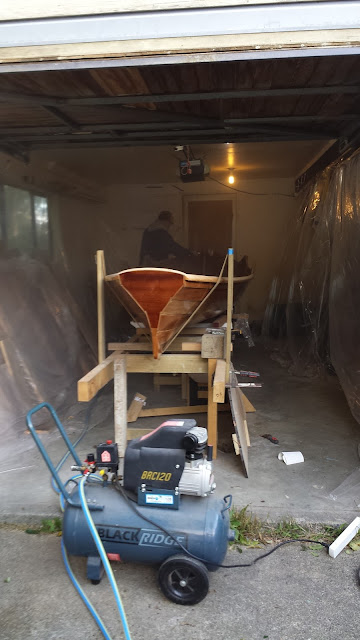It's all very well trying to be entertaining, but, when it comes down to it, we are building a boat and that's not always going to be funny. There was a vague hope that others would gain inspiration and insight from our experience, but unless you find the story of two non-Completer Finishers, procrastinating their way through a project, uplifting, you are probably out of luck. Buckle up, knuckle down, for a worthy few articles on making oars.
The boat, by the way, has had its 8 coats of varnish on the inside and looks wonderful. We have turned it over and will give the outer hull a final sand and then a last coat. We are debating the addition of a brass rubbing strip down the keel: probably a good idea, given the absence of landing stages on the Waikato.
In the meantime, making the oars is just as satisfying as every other stage of the build. Another learning curve, but another pleasing result. Maybe I am getting ahead of myself, but it's turning out that way....
Having prepared the loom (the shaft of the oar) we glued additional lengths of wood at the spoon end to give the necessary width.
 |
| The spoon before shaping |
We also added a mahogany tip, for decoration and also strength, but most of this will disappear during the shaping of the spoon.
Most of the resulting block of laminated wood now needs to be removed to look like Michaelangelo (which is our code for "take away everything that doesn't look like the finished article")
A series of horizontal cuts, then chisel away the surplus, was our initial strategy:
This turned out to be very, very hard work, largely because our saw is rubbish and our chisel not too sharp either. Joe had the right idea: he went and wrote emails while I bashed my thumb repeatedly.
 |
| It's like uncovering a fossil |
Mindless persistence and some heavy work with a sanding disc attached to an angle grinder began to pay off. Since we used different wood types for cap, sides, base and for the width of the spoons, the components are revealed by the shaping process, giving patterns that (we think) add interest.
The mahogany stripes already look nice and we know they will eventually show as a rich glossy brown, contrasting well with the paler wood.
Once the face has been shaped, we then roughly cut away the back before careful, detailed shaping to the template.
 |
| What does it mean when Joe's Welcome Mat is inside pointing the way out? |
At a late stage in the game, we remembered that we had a much better option: we have a router, which will make easy work of the basic shaping. As long as we are careful...
















































